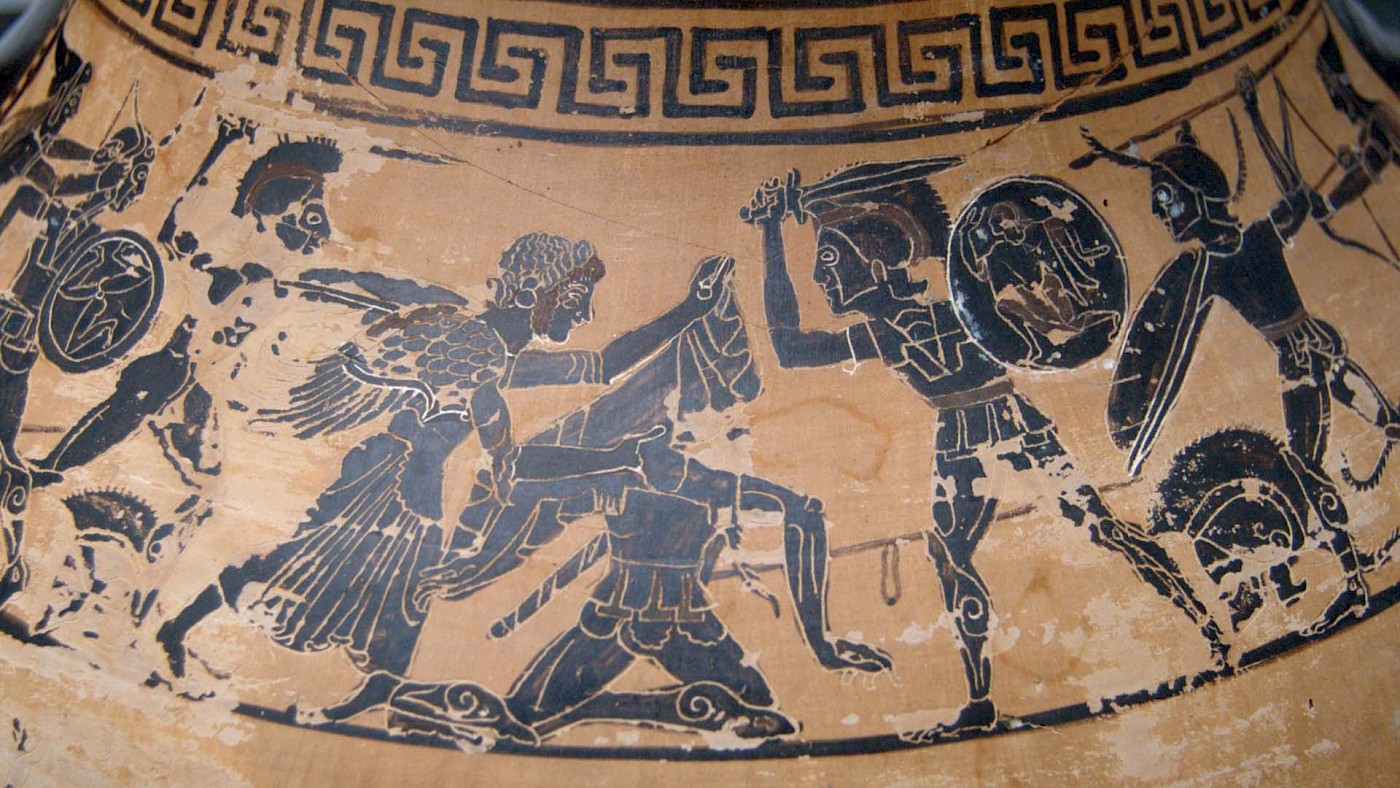O Tydeus’ son, Diomedes, / Bravest Danaan of all, why could I not have fallen on Ilium’s / Plains, spilled forth my soul under your right hand? That’s where savage / Hector was killed by Achilles’ spear, where the mighty Sarpedon / Died, where the Simois snatched up and rolled in the swirl of its waters / So many warriors’ shields, men’s helmets, and valiant bodies!
Thus lamented Aeneas, the great Trojan hero, that he was not killed in front of Troy along with his Dardanian brethren (Virgil, Aeneid 1.96-101; transl. Frederick Ahl). This comes at the beginning of Virgil’s Aeneid, as the ship he is sailing on is thrown about in a violent storm.
His flight to Italy, via Carthage and Sicily, is probably for what he is best known, but his story is much deeper. As Josho has written before, Aeneas’ status as one of the most important and storied heroes of the Trojan War was well-established in the Greek canon before the Romans decided that he was their progenitor.
Aeneas in single combat
In the Iliad, Aeneas’ most famous scene is when fights a duel with one of the mightiest of the Greek horde, Diomedes. Like many of the other murderous barbarians camped outside of Ilios, Diomedes was an imposing figure. He was particularly famous for his strength and the fact that his corslet had been crafted by Hephaestus.
The two met on the battlefield when Aeneas accompanied Pandarus into the fray. The latter was struck down by Diomedes with a well-thrown spear that hit him in the “nose beside the eye / and shattered his white teeth: his tongue / the brazen spearhead severed, tip from root” (Homer, Iliad 5.297-299; translation is Robert Fitzgerald’s Oxford World’s Classics edition).
As his companion’s mangled body fell from its chariot, Aeneas jumped down to defend it from Achaean depredations. He knew that left alone, the Greeks would desecrate the body of Pandarus, as seems to have been the custom in the world of the Iliad. This bravery led to him being attacked by Diomedes, who throws a large stone, hitting him on the hip socket. (Thrown weapons were a mainstay of “Homeric” combat.)
Wounded, Aeneas drops to his knees, propping himself up by one hand. The wound was worse than it may have been because of Diomedes’ great strength. As the pious Dardanian was hunched over, awaiting his fate with a pain-clouded mind, the Argive butcher moved forward, picking up another brazen spear.
But as he moved to strike the killing blow, Aeneas’ mother, the goddess Aphrodite, shielded her son with a corner of her divinely-made robe. Although this obscured Aeneas from Diomedes’ murderous sight, it was not enough to stop his spear entirely. It cut through the cloth and slashed Aphrodite’s hand. Recoiling from this, she flung her son away, to be caught by Apollo and carted off the field.
An amphora from Vulci
The dramatic confrontation between Aeneas and Diomedes can also be found on the upper register of a black figure Etruscan amphora from the early fifth century BC, as depicted in this article’s featured image, above. The amphora was found in Vulci and is now in the Martin von Wagner Museum of Würzburg University. Although the figures are not labelled on this vase, they are easily identifiable. A female figure moves to shield an injured warrior with her robe from an opponent, preparing to strike with his sword.
Obviously, there are a few differences with the version of the story from the Iliad. Firstly, Diomedes is attempting to finish off Aeneas with his sword, rather than a spear. Secondly, Aphrodite appears to be lurching forward immediately with her robe before her, while in the narrative she first receives her son into both of her arms. This is perhaps more faithfully represented on a red-figure vase, below.

The vase from Vulci is an important piece of evidence that Aeneas was of interest in central Italy before the Romans appropriated his story. It is also enlightening that the artist or patron chose to depict this. It is more common in the surviving corpus to find Aeneas carrying his father Anchises away from Troy, rather than his brief fight with Diomedes.
This depiction is also important because it suggests that the story was internalized in Etruscan (or at least Vulcentine) culture. As Otto Brendel pointed out some time ago, its “painter […] was well conversant with Greek art, which, however, he translated into a personal idiom of noticeably Etruscan flavor” (O.J. Brendel, Etruscan Art (1995), p. 198).
In particular, I think that the arms are more in-line with contemporary Etruscan art found elsewhere, notably Diomedes’ sword and shield and the mixed presence of archers and spearmen. The device on Diomedes’ shield is striking and rather odd.
That the depiction was not copied directly from a known Greek example is telling. It suggests that this part of Aeneas’ story was one of the elements of the Trojan myth that found a home in Italy.
